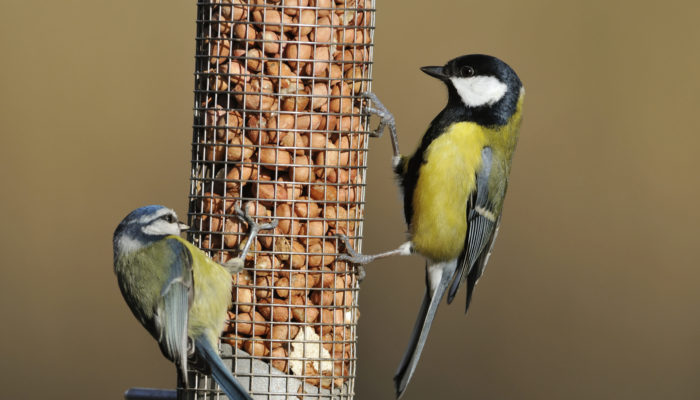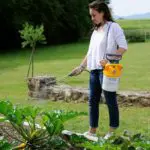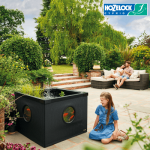Creating a bird-friendly garden is a wonderful way to invite wildlife into your outdoor space while also adding beauty and tranquillity to your surroundings. Birds play a critical role in pollination and pest control, and by creating a welcoming environment for them, you can help to support their populations and contribute to the health of your local ecosystem. Here are some tips to help you create a bird-friendly garden:
Provide a Water Source

Birds need water to drink and bathe, so providing a clean, reliable water source is essential. A bird bath, fountain or small pond can all work well, as long as they are kept clean and filled with fresh water. Place your water source in a visible location so that birds can easily find it.
• It needs to have shallow sloping sides with a shallow approach to water.
• To allow different species to bathe, provide a sloping bath, so the water is between 2.5cm and 10cm (1-4 inches) deep.
• Make sure the surface of the bath is rough so birds can grip it with their claws, and not slip.
• The vigorous bathing of a flock of starlings can use up a lot of water, so make sure your bird bath is big enough.
• The simplest bird bath is a plant saucer with a textured finish and a stone in the middle. You could set several of these around your garden.
Choose Native Plants

Native plants are well-adapted to your climate and provide the food and shelter that birds need. They also attract native insects, which are an important food source for many bird species. Choose a variety of plants that flower and fruit at different times of the year to provide a consistent source of food.
• Planting trees give birds a vantage point safe from most predators as well as sheltered nesting sites. Some trees are also a source of food.
• Hedgerows provide birds with shelter, but also food in the hedgerows themselves and the insects they attract.
• Ivy is a plant which is a huge hit with birds, although one you will need to keep on top of. The plant is perfect for helping birds during the autumn months as they attract insects when not much else is around, perfect for robins and wrens.
• Planting wildflowers is a great way to attract pollinators and the birds that feed on them. Letting them go to seed when the flowering season is over provides a great source of food for birds in the autumn.
Reduce Light
Bright lights can disorient and confuse birds, especially during migration, which can be a critical and vulnerable time for these animals. To help mitigate this risk, it’s important to reduce the amount of artificial light in your garden, particularly during the spring and Autumn migration seasons. By doing so, you can help to ensure that birds are able to navigate safely and reduce their risk of getting lost or injured.
• Position lights as low as possible and aim them downwards or to where they’re needed.
• Fit hoods over the light to reduce light pollution of the night sky
• Turn garden lights off when not in use or use motion sensors or timers for essential or security lighting so they only come on when absolutely necessary
• Choose low-intensity lighting and warmer hues (warm white, yellow or amber): solar lighting is cheap, safe and emits a dull glow suitable for garden use.
Avoid Pesticides

Pesticides can harm birds and other wildlife. Instead, consider using natural pest control methods to keep your garden healthy and thriving.
• Spraying with water or with a light soap solution has been used for some time to remove aphids and similar species from plants.
• Many plant oils and other organic-based substances are totally environment friendly as they use plants’ natural resistance to attack but have a deterrent or lethal impact on specific garden pests.
• By encouraging natural predators of any specific pest into the area, the pest in question will be controlled. Ladybirds, lacewings, frogs, hedgehogs and birds are all great at limiting numbers of garden pests such as aphids and slugs.
Offer Food

While native plants should be the primary source of food for birds in your garden, you can also provide supplemental food in the form of bird feeders. Choose high-quality birdseed and keep your feeders clean and well-maintained to prevent the spread of disease.
• Use wire mesh feeders for peanuts and seed feeders for other seed
• Food placed on wire mesh held just off the ground will entice ground-feeding birds such as robins.
• Finely chopped animal fat and grated cheese are welcomed by small birds, such as wrens
• Sparrows, finches and nuthatches enjoy prising the seeds out of sunflower heads. Also, leave seed heads on herbaceous plants overwinter
• Niger seed is liked by goldfinches
• Peanut cakes for starlings
• Fruit is favoured by thrushes and blackbirds. Scatter over-ripe apples, raisins and song-bird mixes on the ground for them. Consider planting berrying shrubs and trees, including favourites such as Malus, Sorbus, Cotoneaster and Pyracantha
• Mealworms are a favoured food of many garden birds
Provide Shelter

Providing shelter is a key consideration when attempting to attract birds to your garden. Birds need places to rest and hide from predators, so planting trees, shrubs, and thickets can all provide excellent shelter. To create an even more diverse habitat and attract a wider variety of birds, you can also plant in layers of different heights.
• A layered garden provides a diverse habitat for birds and attracts a wider variety of species. Plant tall trees, medium-sized shrubs, and low-growing plants in layers to create a diverse habitat for birds.
• Plant evergreens: Evergreens provide year-round shelter for birds and protect them from harsh weather conditions.
• Birdhouses provide safe and secure nesting sites for birds. Place them in trees or on poles away from predators, and ensure they are the right size and shape for the birds you want to attract.
• Dense shrubs provide excellent cover for birds, especially from predators such as cats. Choose varieties that offer berries or other food sources for birds.
• A brush pile made of sticks and twigs provides excellent shelter for birds, especially during the winter months. Place it in a quiet corner of your garden away from any disturbances.
We hope you enjoyed reading our blog on ‘Creating a Bird Friendly Garden’. If you’d like to get involved, drop us a comment below with your gardening tips!























